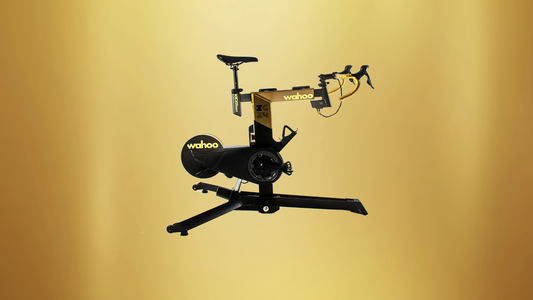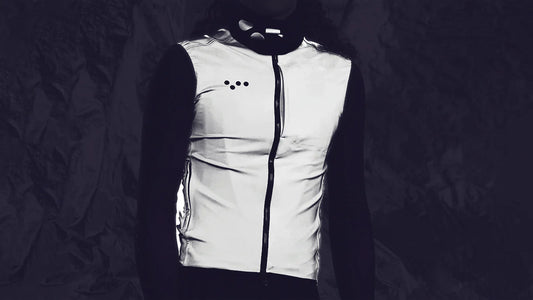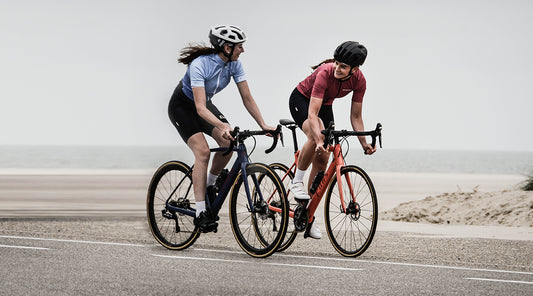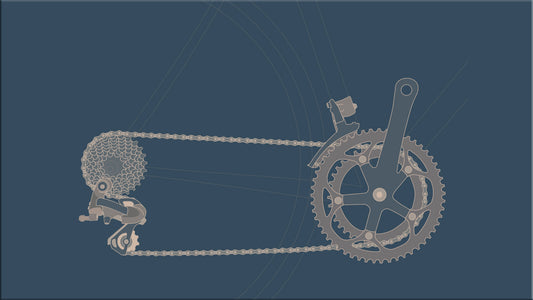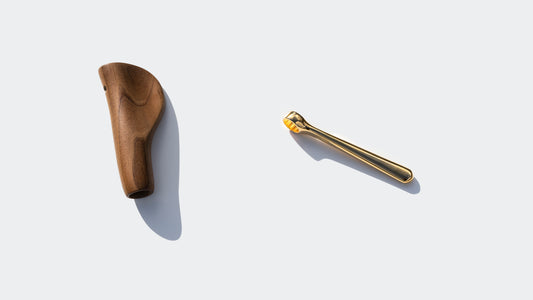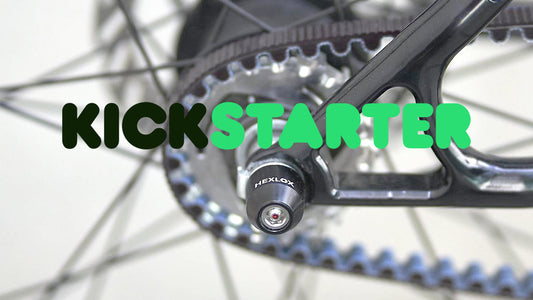Clean your bike - the easy way

SPRING CLEAN YOUR BIKE - THE EASY WAY
You do not have to remove the wheels or chain to get a sparkling clean bike - but if you want to do that you're of course welcome to do that!
Cleaning your bicycle on a regular basis can help improve its performance and definitely extend its lifespan. Here are the steps to follow when cleaning your bike.

Tools you need:
- Bucket
- Hot water
- Bike cleaning solution, or ordinary dish soap,
- Brushes in different sizes - bottle brushes will come in very handy
- Large sponges
- Clean rags
- Chain lubricant - (this is the only bike specific product you will need)
- Bike stand, or something to hold your bike steady. We use a pro-bike stand but if you don't have that simply turn your bike upside down.
- Large towel to protect the floor

A pro bike stand is very helpful - but not necessary. No stand? Just turn the bike upside down!

Make sure to get all the nooks and crannies of the bike, especially around the front and rear wheel and the brakes, where a lot of dirt will get stuck.
1. Get the bike "soapy"
Put down the towel to protect the floor, alternatively you can clean the bike in your bathtub or shower, but ask around in the household first to see if everyone is onboard with this.
Start by rinsing your bike with hot water. If you have a hose, be careful not to aim high-pressure water directly at the bottom bracket, bearings, or hub areas, as this might remove the grease. However, this is unlikely and professional bike mechanics are using pressure washers on a daily basis.
Mix the bike cleaning solution, or mild soap with hot water in a bucket, dip the sponge in the solution, and get to work on the bike. We recommend that you remove the wheels to reach all the "hidden" areas, these areas get really dirty. But if you keep your wheels on, a bottle brush comes in very handy to reach these areas.

Pro tip! Clamp two smaller brushes together to reach into, and thoroughly clean, the chain
2. Clean the drivetrain with degreaser :
It's very important to deep-clean the inside of the chain - the links and rollers - and not just the outside of the chain. Using a degreaser can be particularly effective at removing built-up grime and dirt:
-
Improve chain performance: Over time, dirt and grime can build up on the links and rollers, causing them to become stiff and less responsive. Cleaning them with degreaser can help to loosen up the chain, improving its performance and allowing for smoother shifting.
-
Prevent chain wear: When the links and rollers are dirty, the dirt and grime can act as an abrasive, wearing down the chain faster than normal. By cleaning the rollers with degreaser, you can help to prevent this wear and prolong the life of your chain.
-
Reduce noise: A dirty chain can be noisy, particularly when shifting gears. By cleaning the links and rollers with degreaser, you can help to reduce this noise, making for a more enjoyable and quiet ride.
-
Allow for proper lubrication: If the rollers are dirty, it can be difficult for lubricant to penetrate into the chain and keep it properly lubricated. By cleaning the rollers with degreaser, you can help to ensure that the lubricant is able to do its job, keeping your chain running smoothly.
Overall, cleaning the inside of the chain with degreaser is an important part of bike maintenance that can help to improve the performance and prolong the life of your bicycle chain. It's important to follow the manufacturer's instructions when using degreaser, and to be sure to rinse off the chain thoroughly afterwards to remove any leftover degreaser residue.
When cleaning the drivetrain, it's advisable to protect the surrounding areas of your bike from overspray and debris. Cover your bike frame and wheels with a towel or rag.Pro Tip: Use 2 small brushes clamped together to really get inside the chain. Use the brushes to scrub the chain, derailleur, and cassette. Be sure to get into all the nooks and crannies to remove any dirt. You might have to do this repeatedly, depending on how dirty the drivetrain is.
It's important to note that you need a degreaser to get the drivetrain clean - just soap and water will NOT do the trick here - it's simply too greasy!
Choosing a degreaser:
Look for a degreaser that is biodegradable, as this will be better for the environment.
Make sure the degreaser is non-toxic, as you don't want to risk any harm to yourself or your bike.
Are there alternatives to bicycle degreaser?
Yes, there are alternative methods to clean a bicycle drivetrain if you don't have access to a bicycle degreaser. Here are a few options:
Simple Green or other household cleaners:
Citrus-based cleaners (We use these a lot)
-
Environmentally friendly: Citrus-based cleaners are biodegradable and less harmful to the environment than traditional petroleum-based degreasers.
-
Safer to use: Citrus-based cleaners are generally less toxic and less flammable than petroleum-based degreasers, making them safer to use around people and pets.
-
Effective at removing grease and grime: Despite being gentler than traditional degreasers, citrus-based cleaners are still effective at breaking down and removing grease and grime from your bike's chain.
-
Pleasant smell: Citrus-based cleaners have a pleasant citrus scent that is much more pleasant than the harsh chemical odor of traditional degreasers.
-
Can be used on a wide range of surfaces: Citrus-based cleaners are safe to use on a wide range of surfaces, including painted surfaces, plastic, and rubber.
Overall, citrus-based cleaners are a great choice for bike chain degreasing because they are effective, safe, and environmentally friendly. They offer all the benefits of traditional degreasers without the harsh chemicals or unpleasant odors.
Mineral spirits:
3. Rinse everything off:
It is important to rinse off a bicycle after using degreaser because degreasers are using potent chemicals. However, if left on the bike, the degreaser can also corrode and damage the metal parts of the bicycle. Therefore, it is essential to rinse off the degreaser thoroughly to remove any residue and prevent potential damage.
Additionally, some degreasers can leave a residue that can attract dirt and debris, which can lead to further issues with your bike's performance. Rinsing off the degreaser ensures that your bike is completely clean and ready for the next steps in maintenance or repairs.
4. Dry everything:
5. Lubricate the chain:
6. Additional To-Dos
Check your brakes and gears:
Checking your bicycle's brakes and gears is an essential part of regular bike maintenance. Here are some things to look out for when inspecting your brakes and gears:
- Brakes:
- Brake pads: Check the brake pads to ensure that they have enough material left. If the pads are worn, replace them. Worn brake pads can lead to decreased braking performance, making it more difficult to stop the bike.
- Brake levers: Check the brake levers to make sure that they are operating smoothly and engaging the brakes properly. If the levers feel loose or sluggish, adjust or replace them.
- Brake cables and housing: Check the brake cables and housing for any signs of wear, fraying, or rust. Replace the cables and housing if necessary.
- Brake rotors (for disc brakes): Check the brake rotors to ensure that they are straight, clean, and free from any damage or debris. Warped or damaged rotors can cause brake pulsing or reduced braking performance.
- Gears:
- Shifters: Check the shifters to ensure that they are operating smoothly and engaging the gears properly. If the shifters feel loose or sluggish, adjust or replace them.
- Derailleurs: Check the derailleurs to ensure that they are aligned properly and moving smoothly. If the derailleurs are misaligned or damaged, adjust or replace them.
- Chain: Check the chain for any signs of wear or damage. A worn chain can cause skipping or slipping gears, and may also cause premature wear on the cassette and chainrings.
- Cassette and chainrings: Check the cassette and chainrings for any signs of wear or damage. Worn or damaged cassettes or chainrings can cause poor shifting performance.
By regularly inspecting your brakes and gears for these issues, you can ensure that your bike is safe to ride and performing at its best.
Check your tires:
Inspecting your bicycle tires is an essential part of bike maintenance, and it's important to do it regularly to ensure your safety and prolong the lifespan of your tires. Here are some things to look out for when inspecting your bicycle tires:
-
Tread Wear: Check the condition of the tire tread. If the tread is worn down, it may be time to replace the tire. Tires with worn tread may not provide sufficient traction, making it difficult to ride safely, especially in wet or slippery conditions.
-
Cuts and Punctures: Look for cuts, punctures, or embedded debris on the tire. Small cuts or punctures can be repaired with a patch kit, but larger or deeper cuts may require tire replacement. Embedded debris like glass or nails can cause punctures or flats, so it's important to remove them as soon as possible.
-
Sidewall Damage: Check the sidewall of the tire for any signs of cracking, bulging, or other damage. If the sidewall is damaged, the tire is no longer safe to ride and must be replaced.
-
Proper Inflation: Check the tire pressure using a tire pressure gauge to ensure the tire is inflated to the recommended pressure range. Underinflated tires can cause increased rolling resistance, reduced handling, and increased risk of flats. Overinflated tires can lead to reduced traction, decreased handling, and a harsh ride.
-
Tires Mismatch: Check to ensure that both tires have the same size and type. Using mismatched tires can affect the bike's handling and performance.
By regularly inspecting your bicycle tires for these issues, you can help ensure your safety on the road, prolong the lifespan of your tires, and prevent costly repairs.
